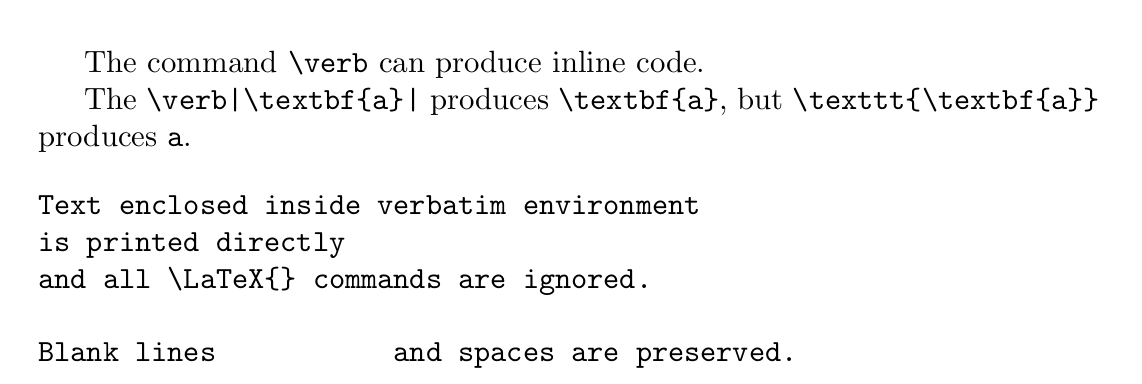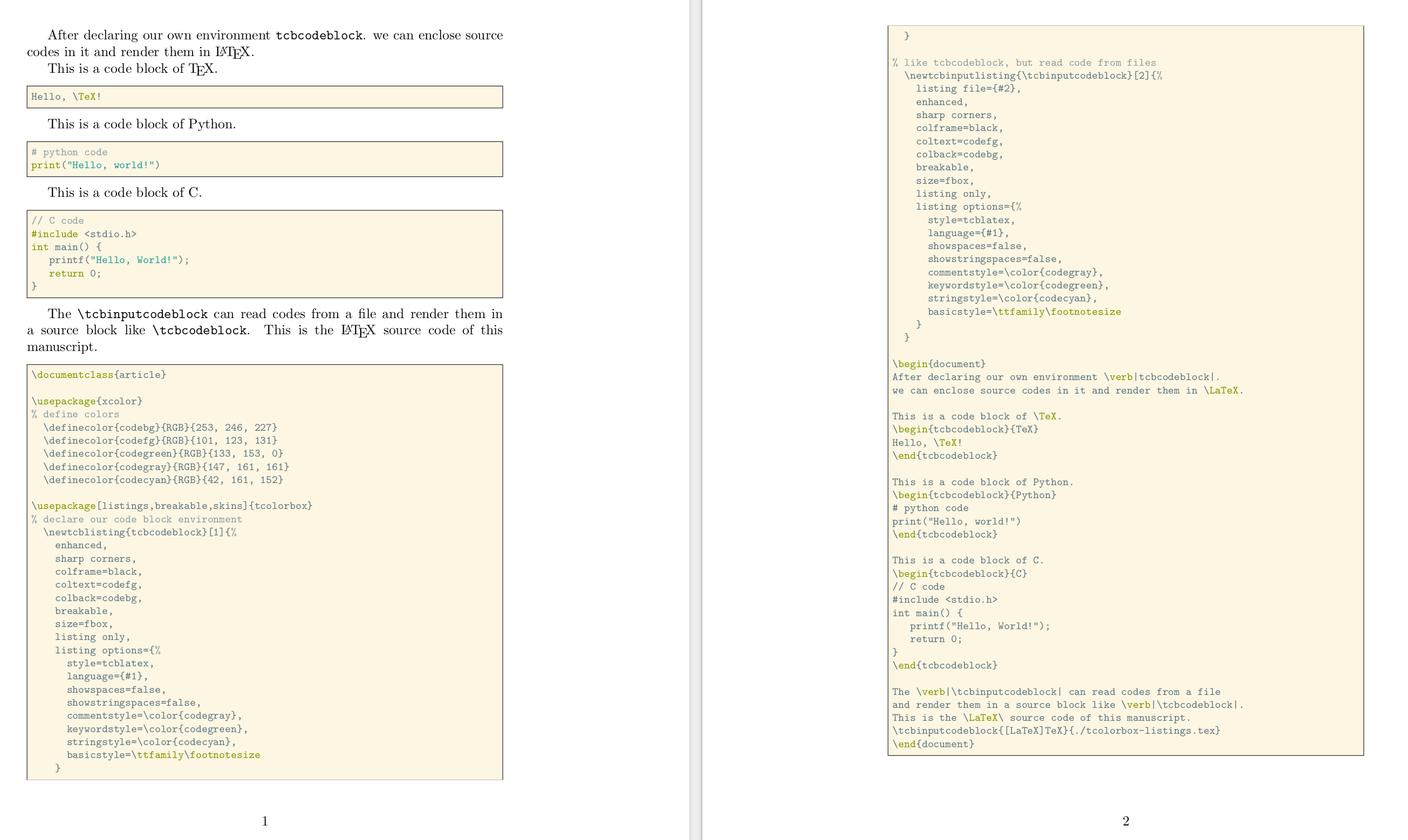Insert Code Block in LaTeX
The most simple way of inserting code blocks in LaTeX is the built-in
command \verb and environment verbatim.
The command \verb can produce inline code. It is better than
\texttt for source code because characters in \verb will be treated
literally. For example, \verb+\textbf{a}+ produces \textbf{a}
in monospace font, but \texttt{\textbf{a}} produces a single
character a, in bold monospace font. Here, the + character after \verb
acts as a delimiter. Any character except letters and * can be used as a delimiter
in \verb. For example, \verb|...| is equivalent to \verb+...+.
Similar to \verb, texts enclosed inside the environment verbatim are printed literally.
\documentclass{article} \begin{document} The command \verb|\verb| can produce inline code. The \verb+\verb|\textbf{a}|+ produces \verb|\textbf{a}|, but \verb+\texttt{\textbf{a}}+ produces \texttt{\textbf{a}}. \begin{verbatim} Text enclosed inside verbatim environment is printed directly and all \LaTeX{} commands are ignored. Blank lines and spaces are preserved. \end{verbatim} \end{document}
The LaTeX code above produces the following output.

Besides the built-in commands, there are various packages providing more features for redering code blocks.
These packages generally are more powerful and can add syntax highlighting, line numbers, background color
and etc. Usual choices include listings package, minted package
and tcolorbox package. While listings and minted are mainly focusing on redering source codes,
tcolorbox is a general package for redering contents in a box.
Actually, tcolorbox internally loads listings or minted packages.
Create Own Code Block Environment with tcolorbox
When tcolorbox is loaded with the option listings, it provides various useful predefined commands
for rendering source blocks by loading listings package automatically. Besides the listings option,
we can also toggle the breakable option to allow a box to span across pages.
In the following example, we create two code block envrionments with tcolorbox and listings in preamble.
These two envrionments are basically identical, except that one can read code from external
files and we do no need to copy the code from source files into our latex manuscript.
\documentclass{article} \usepackage{xcolor} % define colors \definecolor{codebg}{RGB}{253, 246, 227} \definecolor{codefg}{RGB}{101, 123, 131} \definecolor{codegreen}{RGB}{133, 153, 0} \definecolor{codegray}{RGB}{147, 161, 161} \definecolor{codecyan}{RGB}{42, 161, 152} \usepackage[listings,breakable,skins]{tcolorbox} % declare our code block environment \newtcblisting{tcbcodeblock}[1]{% enhanced, sharp corners, colframe=black, coltext=codefg, colback=codebg, breakable, size=fbox, listing only, listing options={% style=tcblatex, language={#1}, showspaces=false, showstringspaces=false, commentstyle=\color{codegray}, keywordstyle=\color{codegreen}, stringstyle=\color{codecyan}, basicstyle=\ttfamily\footnotesize } } % like tcbcodeblock, but read code from files \newtcbinputlisting{\tcbinputcodeblock}[2]{% listing file={#2}, enhanced, sharp corners, colframe=black, coltext=codefg, colback=codebg, breakable, size=fbox, listing only, listing options={% style=tcblatex, language={#1}, showspaces=false, showstringspaces=false, commentstyle=\color{codegray}, keywordstyle=\color{codegreen}, stringstyle=\color{codecyan}, basicstyle=\ttfamily\footnotesize } }
In the main document, we can use tcbcodeblock as a normal environment
with one mandatory argument, which specifies the language of source code,
and use tcbinputcodeblock as a normal command with two mandatory arguments,
which specify the language of source code and the name of the source file.
See the table in the manual of listings for a complete list of supported languages.
\begin{document} After declaring our own environment \verb|tcbcodeblock|. we can enclose source codes in it and render them in \LaTeX. This is a code block of \TeX. \begin{tcbcodeblock}{TeX} Hello, \TeX! \end{tcbcodeblock} This is a code block of Python. \begin{tcbcodeblock}{Python} # python code print("Hello, world!") \end{tcbcodeblock} This is a code block of C. \begin{tcbcodeblock}{C} // C code #include <stdio.h> int main() { printf("Hello, World!"); return 0; } \end{tcbcodeblock} The \verb|\tcbinputcodeblock| can read codes from a file and render them in a source block like \verb|\tcbcodeblock|. This is the \LaTeX\ source code of this manuscript. \tcbinputcodeblock{[LaTeX]TeX}{./tcolorbox-listings.tex} \end{document}

Explanation of the Created Code Environment
First, we load tcolorbox with appropriate options. In addition, we load the xcolor package for color support.
\usepackage{xcolor} \usepackage[listings,breakable,skins]{tcolorbox}
Then, we create our own code environment for furture uses.
% define colors \definecolor{codebg}{RGB}{253, 246, 227} \definecolor{codefg}{RGB}{101, 123, 131} \definecolor{codegreen}{RGB}{133, 153, 0} \definecolor{codegray}{RGB}{147, 161, 161} \definecolor{codecyan}{RGB}{42, 161, 152}
After that, we create a new envrionment tcbcodeblock with one argument, which is used to specify the code language.
This envrionment can render source code in a box with following features.
- Use the
enhancedskin. - Box corners are squared.
- Box borders are drawn with black lines.
- Text color is set to
codefg, which is defined previously by RGB(101, 123, 131). - Background color is set to
codebg, which is defined previously by RGB(253, 246, 227). - This box can span across multiple pages.
- Minimal margin layout with
\fboxstyle. - Show code only (if the source code is latex manuscript, you can remove the
listing onlyoption to show the expected latex output of the latex code enclosed in this envrionment). - Use the predefined style
tcblatex. This overwirtes options of thelistingspackage by options oftcolorboxpackage. If this line is absent, some of your settings oftcolorboxwill not take effects in this environment. - Set the language of the source code. This is used to identify strings, comments and keywords in the code.
- Does not render space as character
␣. - Does not render space in strings as character
␣. - Text color of comments, keywords and strings are set to
codegray,codegreenandcodecyanrespectively. - Set text font to monospace and footnote size.
% declare our code block environment \newtcblisting{tcbcodeblock}[1]{% enhanced, sharp corners, colframe=black, coltext=codefg, colback=codebg, breakable, size=fbox, listing only, listing options={% style=tcblatex, language={#1}, showspaces=false, showstringspaces=false, commentstyle=\color{codegray}, keywordstyle=\color{codegreen}, stringstyle=\color{codecyan}, basicstyle=\ttfamily\footnotesize } }
In addition, we provide a command tcbinputcodeblock, which functions like tcbcodeblock but
read code from external files. It accepts two arguments, one is the language and the other one is the
name of the source file.
% like tcbcodeblock, but read code from files \newtcbinputlisting{\tcbinputcodeblock}[2]{% listing file={#2}, enhanced, sharp corners, colframe=black, coltext=codefg, colback=codebg, breakable, size=fbox, listing only, listing options={% style=tcblatex, language={#1}, showspaces=false, showstringspaces=false, commentstyle=\color{codegray}, keywordstyle=\color{codegreen}, stringstyle=\color{codecyan}, basicstyle=\ttfamily\footnotesize } }